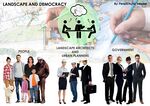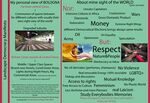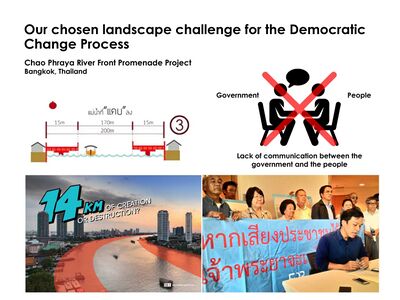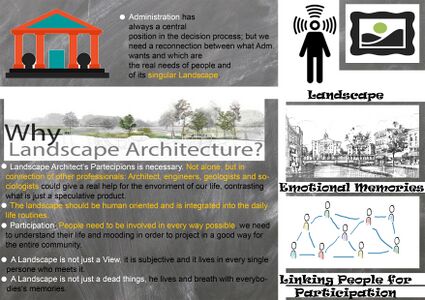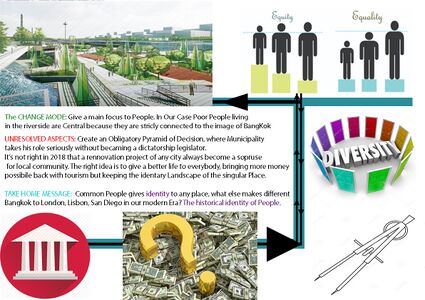LED Online Seminar 2018 - Working Group 6: Difference between revisions
Penpichcha (talk | contribs) |
|||
| (76 intermediate revisions by 5 users not shown) | |||
| Line 28: | Line 28: | ||
'''A: Landscape and Democracy''' | '''A: Landscape and Democracy''' | ||
Penpichcha : International Federation of Landscape Architects (IFLA-Europe), Landscape Democracy Resolution | |||
Rana : Burckhardt, Lucius (1979): Why is landscape beautiful? in: Fezer/Schmitz (Eds.) Rethinking Man-made Environments (2012) | |||
Victor : Bruns/Bartolomei, 2016 'Concepts of Landscape | |||
Davide : Meinig, D. W. (1979): "The Beholding Eye: Ten Versions of the Same Scene." In: The Interpretation of Ordinary Landscapes: Geographical Essays, edited by D. W. Meinig and John Brinckerhoff Jackson, 33-48. New York: Oxford University Press. | |||
'''B: Concepts of Participation''' | '''B: Concepts of Participation''' | ||
Penpichcha : Arnstein, Sherry R.(1969): A Ladder of Citizen Participation, JAIP, Vol. 35, No. 4 | |||
Rana : Hester, Randolph (2012): Evaluating Community Design, Landscape Journal | |||
Victor : Gaventa, John: The Powerful, the Powerless, and the Experts | |||
Davide : Davis, Mike (1990): Fortress Los Angeles: The Militarization of Urban Space, From: City of Quartz: Excavating the Future in Los Angeles | |||
'''C: Community and Identity''' | '''C: Community and Identity''' | ||
Penpichcha : Hester, Randolph (2006): Design for Ecological Democracy, The MIT Press | |||
Rana : Welk Von Mossner, Alexa (2014): Cinematic Landscapes, In: Topos, No. 88, 2014. | |||
Victor : Girling, Cynthia (2006): Informing Design Charrettes, The Integrated Assessment Journal | |||
Davide : Gafford, Farrah D. (2013): It Was a Real Village: Community Identity Formation Among Black Middle-Class Residents in Pontchartrain Park, Journal of Urban History 39:36 | |||
'''D: Designing''' | '''D: Designing''' | ||
Penpichcha : Hester, Randolph: Democratic Drawing - Techniques for Participatory Design | |||
Rana : Smith, Nicola Dawn(2012): Design Charrette: A Vehicle for Consultation or Collaboration | |||
Victor : Massachusetts Institute of Technology (2013): Places in the Making: How Placemaking Builds Places and Communities | |||
'''E: Communicating a Vision''' | '''E: Communicating a Vision''' | ||
Penpichcha : A toolkit for transforming abandoned spaces through the arts. https://issuu.com/mahatat/docs/toolkit_en._final_issuu | |||
Victor : Online decision making with loomio | |||
=== Steps 3 and 4: Concepts Selection and definition === | === Steps 3 and 4: Concepts Selection and definition === | ||
| Line 55: | Line 83: | ||
'''Concepts and definitions''' | '''Concepts and definitions''' | ||
'''Author 1: | '''Author 1: Penpichcha Saiwilai''' | ||
* | *The citizens are involved both individually or through elections in the decision making for the landscape and open spaces in the community equally. | ||
* | *The people can get an access to the decision making about how to shape the landscape through their daily life routine. | ||
* | *The landscape design must integrate the modern and up-to-date needs of the people with their daily life pattern. | ||
'''Author 2: | '''Author 2: Rana Shukayr''' | ||
*.. | *How people define a landscape and how it is viewed differently by each person. Having experiments with different point of views about what is landscape and how they see it and label it. All this showed that it was related to background, memories, cultures, and discoveries. | ||
*. | *The core of creating a landscape design is to engage the community by making them participate not only theoretically but with all their senses physically and emotionally. By doing so, these creative ideas with no barriers elevated the design of the landscape. | ||
*.. | *A wake up call for people watching the movie about the crisis of landscape. Showing the extreme emotional distress and the sufferings through the landscape. The aim is to give hope and resilience for the community living such dangers. | ||
'''Author 3: | '''Author 3: Davide Coccolini''' | ||
* | *Landscape as meaning: we should understand this term cover alone any of the aspects of a single place: how it looks, how it has been built, how it is lived, how it lives in our memories, but expeccialy what we feel walking through it. "Landscape as an integrating concept, is exinstentially highly significant and serves as a natural and cultural heritage that deserves full attention" citation by Kuhne Olaf, Landscape concepts. | ||
*We need a come back to the "humanization of the public space" in order to keep its back to a Human dimension. Not using palliative situations, but structural ones. People need feeling to be part of a totality, not a mere mathematic number | |||
*we need to evolve from the idea to built spaces for a exact class. we need to design the city as a complete system of interactions. Designing is the pen to cure the segregation. | |||
*.. | |||
*.. | |||
=== Step 5: Reflection === | === Step 5: Reflection === | ||
| Line 89: | Line 107: | ||
<gallery caption=" " widths="150px" heights="150px" perrow="5"> | <gallery caption=" " widths="150px" heights="150px" perrow="5"> | ||
Image: | Image:20180619 Revised Manifesto.jpg|Penpichcha Saiwilai's updated manifesto | ||
Image: | Image:Rana Shukayr revised manifesto.jpg|Rana Shukayr's updated manifesto | ||
Image:MANIFESTO DAVIDE COCCOLINI.jpg|Davide Coccolini's updated manifesto | |||
Image: | |||
</gallery> | </gallery> | ||
| Line 123: | Line 139: | ||
</gallery> | </gallery> | ||
=== Landscape Symbols Author 5: | === Landscape Symbols Author 5: Davide Coccolini === | ||
<gallery caption=" " widths="150px" heights="150px" perrow="5"> | <gallery caption=" " widths="150px" heights="150px" perrow="5"> | ||
Image: | Image:Due-torri-2.jpg|Here one the most famous touristic symbol of my city, Bologna. These are the Two Towers (DUE TORRI). This sight recapitulates all you need to now about the origin of this city. | ||
Image: | Image:Panoramica bologna tetti vista colli-2.jpg|ones of the most famous elements of Bologna, The historical plaza "piazza Maggiore" with the Cathedral of San Peter, far away over the hill the Sanctuary of "San Luca's Madonna" | ||
Image: | Image:Aerial-view-from-above-of-the-Pilastro-neighborhood.png|here one the most famous Suburb in Bologna, It was build during '60s as a low Class zone, during the decades it became a crime famous location. He really need a good restoration. | ||
</gallery> | </gallery> | ||
| Line 144: | Line 154: | ||
*You can read more details about this assignment [[Assignment_4:_Your_Landscape_Democracy_Challenge_(2018)|here]] | *You can read more details about this assignment [[Assignment_4:_Your_Landscape_Democracy_Challenge_(2018)|here]] | ||
*Each group member will specify a landscape democracy challenge in his/her environment | *Each group member will specify a landscape democracy challenge in his/her environment | ||
*Each Landscape Democracy Challenge should be linked to two or three of [https://www.un.org/sustainabledevelopment/sustainable-development-goals/ UN's 17 sustainable development Goals] | |||
=== Landscape Democracy Challenge 1 === | === Landscape Democracy Challenge 1 === | ||
<gallery caption=" | <gallery caption="Penpichcha Saiwilai - Chao Phraya Riverfront Promenade Project" widths="150px" heights="150px" perrow="7"> | ||
Image: | Image:20180512 A4 01 River.jpg|caption: The Chao Phraya River is the main river of Thailand. This project, of course, affects a lot of people. | ||
Image: | Image:20180512 A4 02 Promenade.jpg|caption: the Bangkok Metropolitan Administration would like to construct the Chao Phraya Riverfront Promenade. | ||
Image: | Image:20180512 A4 03 Protest.jpg|caption: Many people are concerned with the project because the promenade will further destroy the ecosystem of the river, lessen its width as well as obstruct the view. | ||
Image: | Image:20180512 A4 04 Involvers.jpg|caption: the Bangkok Metropolitan Administration, the architects/ engineers/ urban planners, the local people, and the citizen. | ||
Image:20180512 A4 05 UNGoal 3.jpg|caption: UN's Sustainable Development Goal Number 3 - Good Health and Well-Being | |||
Image:20180512 A4 05 UNGoal 11.jpg|caption: UN's Sustainable Development Goal Number 11 - Sustainable Cities and Communities | |||
</gallery> | </gallery> | ||
'''Your references:''' | '''Your references:''' | ||
*.. | *https://www.straitstimes.com/asia/se-asia/shaky-start-for-chao-phraya-river-promenade-project | ||
*.. | *https://www.aseantoday.com/2017/08/chao-phraya-riverside-promenade-development-for-the-few-devastation-for-the-many/ | ||
=== Landscape Democracy Challenge 2 === | === Landscape Democracy Challenge 2 === | ||
<gallery caption=" | <gallery caption="Rana - Ramlet el Bayda: Citizens' right" widths="150px" heights="150px" perrow="7"> | ||
Image: | Image:RanaShukayr_challenge_1.jpg.jpg|caption: The Ramlet el Bayda beach located on the seashore of Lebanon’s capital, Beirut, is threatened by the ongoing privatization of most of the capital’s publicly used spaces, started during the chaos of the Lebanese Civil War. | ||
Image:Niels upload Rana challenge 2.jpg|caption: The last public beach on Beirut's heavily developed seaside will be transformed into another luxury resort, raising fears that residents could find themselves living in a coastal city without much of a coast. Three major issues hinder its sustainability and public access: 1.Pollution: Four sewage outlets are currently discharged into the sea. 2.Private ownership: The beach is owned by private real-estate companies. 3.Maintenance: The absence of an integrated and all-inclusive sustainable urban design. | |||
Image: | Image:RanaShukayr_challenge_3edit.jpg|caption: Construction had started on Ramlet el Bayda public beach in Beirut, which sparked outrage among civil society in Lebanon working on protecting public spaces. The selling of parts of Ramlet Al-Bayda is in violation of this article. The remaining area of public beach will also become a resort, inaccessible to those who currently use and rely upon it. Access to public spaces is of much societal importance | ||
Image:RanaShukayr_challenge_4.jpg.jpg|caption: The project is to build a private resort, on a plot of land to the south of Ramlet el Bayda, being illegally developed by a real estate company and the government is doing nothing about it only citizens and NJOs are fighting it and protesting. | |||
Image:RanaShukayr_challenge_5.jpg|caption:Goal 14: Conserve and sustainably use the oceans, seas and marine resources.To ensure the public’s right to access a clean beach. To providing a safe and clean environment for the visitors | |||
Image:RanaShukayr_challenge_6.jpg|caption: Goal 16: Promote just, peaceful and inclusive societies. The beach and public spaces are human's right. | |||
Image: | |||
Image: | |||
Image: | |||
Image: | |||
</gallery> | </gallery> | ||
'''Your references:''' | '''Your references:''' | ||
* | *https://ejatlas.org/conflict/ramlet-el-bayda-lebanon | ||
*https://stepfeed.com/beirut-is-destroying-its-only-public-beach-these-photos-will-convince-you-to-care-4989 | |||
=== Landscape Democracy Challenge 5 === | === Landscape Democracy Challenge 5 === | ||
<gallery caption=" | <gallery caption="Davide Coccolini - T-DAY, pedestrianization of Bologna City Center, during all the Weekends" widths="150px" heights="150px" perrow="7"> | ||
Image: | Image:Pag 1.jpg|caption: An important case for the Landscape of Bologna city center | ||
Image: | Image:Pag 2.jpg|caption: great deseas for resident people | ||
Image: | Image:Pag 3.jpg|caption: speculations | ||
Image: | Image:Pag 4.jpg|caption: conflict between all the figures of the zone, municipality, its workers vs vendors and community | ||
Image:Pag 5.jpg|caption: 09 | |||
Image:Pag 6.jpg|caption: 11 a little final reflection. Could someone say: <<the project is good>> just because people use it? | |||
</gallery> | </gallery> | ||
'''Your references:''' | '''Your references:''' | ||
* | *papers and partecipation in public discussions from 2011 to 2014 | ||
*... | *http://www.bolognatoday.it/cronaca/t-days-indagine-cittadini-pedonalizzazione.html | ||
== Assignment 5 - Your Democratic Change Process == | == Assignment 5 - Your Democratic Change Process == | ||
| Line 206: | Line 202: | ||
=== Your Democratic Change Process === | === Your Democratic Change Process === | ||
<gallery caption=" | <gallery caption="Change Process for Chao Phraya River in Thailand" widths="600px" heights="300px" perrow="1"> | ||
Image: | Image:Assignment 5 LED.jpg|"Our Choice, Our battle" | ||
Image: | Image:Slide 2group6.jpg|Slide 2group6.jpg | ||
Image: | Image:Slide 3group6.jpg|the masterplan of Promenade by BMA (Bangkok Municipality Administration) first step 15 km, other is 50. The project is really aggressive. | ||
Image: | Image:Slide 4.jpg|Here we choose to Recreate a method. The first step was to obtain the recognition of this landscape as unique, UNESCO what else? The preservation of some of the spontaneous river house, the riverside as it is born with the first agglomeration is necessary. Then the creation of a WEB-PORTAL just for sending pictures,drowns or just notes by people, tourists and student. The main objective there is the need of a community soul. Only then the discussion should moves to strategic tables with investors, professional and Municipality; Keeping central the Emotional Landscape of this city; and just from this point we should start with a structural process, keeping strong all the connections between the parts. | ||
Image:Slide 5 real.jpg|On the right our main theme: the perception of the local and the perception every Landscape give to everybody in decades. Here we wrote down what we have understood discussing about the suggested readings and our challenges. Main point was the Administration, totally necessary in a democratic process but often it doesn't prove its importance.The importance of professionals like Landscape Architect, not intended as a Super God of design but in a more useful way: the personalities who watch though the nature of the reality.The importance of Participation process. Everybodies need to be involved, just for fun, for jokes... or maybe seriously. but we need to give to people a new perspective for their daily spaces. The meaning of Landscape, as a living and breathing system. | |||
Image:Slide 6.jpg|Here we want to show the most important things we learn. Basically if a project, and idea or whatever will change a Landscape should me propose with people in the center, without falling in love with our singular idea of transformation.People and their life is what makes a Landscape unique and different all over the world. | |||
</gallery> | </gallery> | ||
=== Reflection === | === Reflection === | ||
* . | * Davide Coccolini: The interesting thing in this course has been the interest showed and the conveying passion communicated to us. | ||
* | Starting from a muddler point, lesson by lesson I think we get a clearer way to understand and interact with our present. | ||
* Penpichcha Saiwilai : This assignment is a good exercise for us to identify the conflict that is actually happening and and to try to find the way to solve it. | |||
* .... | * .... | ||
Conclusion: | Conclusion: | ||
* .... | * Davide Coccolini: The Democratic Challenge is really hard and its main feature is one:we need to project without any point set in concrete a part the respect for the | ||
* | community identity, each different from the others. Trying to involve and make reasonable the various personality involved. In my experience this is a point 0. thank You... | ||
* Penpichcha Saiwilai : Landscape Education for Democracy should be promoted and integrated into the school curriculum because people should be able to practice and participate in the decision making. | |||
* .... | * .... | ||
=== Your references === | === Your references === | ||
* | * Giancarlo de Carlo, "L'architettura della partecipazione", Quodlibet, Macerata 2013 | ||
* ... | *http://www.realist.co.th/blog/ทางเลียบแม่น้ำเจ้าพระย/ | ||
* ... | * ... | ||
Latest revision as of 13:17, 22 June 2018
--> Back to working group overview
Dear working group members. This is your group page and you will be completing the template gradually as we move through the seminar. Good luck and enjoy your collaboration!
Assignment 1 - Reading and Synthesizing Core Terminology
- You can read more details about this assignment here
- Readings are accessible via the resources page
Step 1: Your Landscape Democracy Manifestoes
Step 2: Define your readings
- Please add your readings selection for the terminology exercise before April 18:
A: Landscape and Democracy
Penpichcha : International Federation of Landscape Architects (IFLA-Europe), Landscape Democracy Resolution
Rana : Burckhardt, Lucius (1979): Why is landscape beautiful? in: Fezer/Schmitz (Eds.) Rethinking Man-made Environments (2012)
Victor : Bruns/Bartolomei, 2016 'Concepts of Landscape
Davide : Meinig, D. W. (1979): "The Beholding Eye: Ten Versions of the Same Scene." In: The Interpretation of Ordinary Landscapes: Geographical Essays, edited by D. W. Meinig and John Brinckerhoff Jackson, 33-48. New York: Oxford University Press.
B: Concepts of Participation
Penpichcha : Arnstein, Sherry R.(1969): A Ladder of Citizen Participation, JAIP, Vol. 35, No. 4
Rana : Hester, Randolph (2012): Evaluating Community Design, Landscape Journal
Victor : Gaventa, John: The Powerful, the Powerless, and the Experts
Davide : Davis, Mike (1990): Fortress Los Angeles: The Militarization of Urban Space, From: City of Quartz: Excavating the Future in Los Angeles
C: Community and Identity
Penpichcha : Hester, Randolph (2006): Design for Ecological Democracy, The MIT Press
Rana : Welk Von Mossner, Alexa (2014): Cinematic Landscapes, In: Topos, No. 88, 2014.
Victor : Girling, Cynthia (2006): Informing Design Charrettes, The Integrated Assessment Journal
Davide : Gafford, Farrah D. (2013): It Was a Real Village: Community Identity Formation Among Black Middle-Class Residents in Pontchartrain Park, Journal of Urban History 39:36
D: Designing
Penpichcha : Hester, Randolph: Democratic Drawing - Techniques for Participatory Design
Rana : Smith, Nicola Dawn(2012): Design Charrette: A Vehicle for Consultation or Collaboration
Victor : Massachusetts Institute of Technology (2013): Places in the Making: How Placemaking Builds Places and Communities
E: Communicating a Vision
Penpichcha : A toolkit for transforming abandoned spaces through the arts. https://issuu.com/mahatat/docs/toolkit_en._final_issuu
Victor : Online decision making with loomio
Steps 3 and 4: Concepts Selection and definition
- Each group member selects three relevant concepts derived from his/her readings and synthesize them/publish them on the wiki by May 9, 2018
- Group members reflect within their groups and define their chosen concepts into a shared definition to be posted on the wiki by June 6, 2018.
- Other group members will be able to comment on the definitions until June 12, 2018
- Each group will also report on their process to come to a set of shared definitions of key landscape democracy concepts on the wiki documentation until June 20, 2018
Concepts and definitions
Author 1: Penpichcha Saiwilai
- The citizens are involved both individually or through elections in the decision making for the landscape and open spaces in the community equally.
- The people can get an access to the decision making about how to shape the landscape through their daily life routine.
- The landscape design must integrate the modern and up-to-date needs of the people with their daily life pattern.
Author 2: Rana Shukayr
- How people define a landscape and how it is viewed differently by each person. Having experiments with different point of views about what is landscape and how they see it and label it. All this showed that it was related to background, memories, cultures, and discoveries.
- The core of creating a landscape design is to engage the community by making them participate not only theoretically but with all their senses physically and emotionally. By doing so, these creative ideas with no barriers elevated the design of the landscape.
- A wake up call for people watching the movie about the crisis of landscape. Showing the extreme emotional distress and the sufferings through the landscape. The aim is to give hope and resilience for the community living such dangers.
Author 3: Davide Coccolini
- Landscape as meaning: we should understand this term cover alone any of the aspects of a single place: how it looks, how it has been built, how it is lived, how it lives in our memories, but expeccialy what we feel walking through it. "Landscape as an integrating concept, is exinstentially highly significant and serves as a natural and cultural heritage that deserves full attention" citation by Kuhne Olaf, Landscape concepts.
- We need a come back to the "humanization of the public space" in order to keep its back to a Human dimension. Not using palliative situations, but structural ones. People need feeling to be part of a totality, not a mere mathematic number
- we need to evolve from the idea to built spaces for a exact class. we need to design the city as a complete system of interactions. Designing is the pen to cure the segregation.
Step 5: Reflection
Step 6: Revised manifestoes
- please look again at your initial manifestoes and update them with any new aspects/prespectives you have taken up during this seminar
Assignment 2 - Your Landscape Symbols
- You can read more details about this assignment here
Landscape Symbols Author 1: Penpichcha Saiwilai
Bangkok, Thailand. This building and its surrounding area were once the palace of the Thai Royal Family. It was builtabout a hundred years ago. Later on, this area became an art school founded by Professor Silpa Bhirasri (Corrado Feroci. Nowadays, it is the location of the Wang ThaPhra Campus of Silpakorn University)
Landscape Symbols Author 2: Rana Shukayr
Corniche, Beirut, Lebanon. A seaside promenade in Beirut Central District. It is 4.8 kilometers long, and encircles a big part of Beirut promontory.There is a natural landmark called the Pigeons' Rock which makes it a popular destination for locals and visitors alike. The Corniche is a common destinations for walkers, joggers and bikers, and also for vendors.
Landscape Symbols Auther 3:Victor Mwata
Uhuru parks located in Nairobi Kenya,is an assembly ground which symbolises the political structure of Kenya. The ground consist of several monuments associated with Kenyan politics and it's infamous as the site where protest against illegal land grabbing was violently broken. However over the years it has attracted various recreation activities. (one paragraph max) description of the symbolism, interpretation, as well as geo-location
Mount Kenya, The second highest mountain in Africa after mount Kilimanjaro is known as the source of the name Republic of Kenya. The mountain is located in central Kenya with its significance being it's scenic beauty and biodiversity.Moreover it attracts tourist all over. (one paragraph max) description of the symbolism, interpretation, as well as geo-location
Tom mboya statue found along Mouth avenue in Nairobi was erected in honor of the prominent political figure, Tom mboya who was assassinated in 1969.The monument has become prominent and popular due to its strategic location.It has also changed the landscape and perception of people by attracting various people to gather around it. In addition it's used as pointers in giving direction. (one paragraph max) description of the symbolism, interpretation, as well as geo-location
Landscape Symbols Author 5: Davide Coccolini
Assignment 3 - Role Play on Landscape Democracy "movers and shakers"
- You can read more details about this assignment here
Assignment 4 - Your Landscape Democracy Challenge
- You can read more details about this assignment here
- Each group member will specify a landscape democracy challenge in his/her environment
- Each Landscape Democracy Challenge should be linked to two or three of UN's 17 sustainable development Goals
Landscape Democracy Challenge 1
- Penpichcha Saiwilai - Chao Phraya Riverfront Promenade Project
Your references:
- https://www.straitstimes.com/asia/se-asia/shaky-start-for-chao-phraya-river-promenade-project
- https://www.aseantoday.com/2017/08/chao-phraya-riverside-promenade-development-for-the-few-devastation-for-the-many/
Landscape Democracy Challenge 2
- Rana - Ramlet el Bayda: Citizens' right
caption: The last public beach on Beirut's heavily developed seaside will be transformed into another luxury resort, raising fears that residents could find themselves living in a coastal city without much of a coast. Three major issues hinder its sustainability and public access: 1.Pollution: Four sewage outlets are currently discharged into the sea. 2.Private ownership: The beach is owned by private real-estate companies. 3.Maintenance: The absence of an integrated and all-inclusive sustainable urban design.
caption: Construction had started on Ramlet el Bayda public beach in Beirut, which sparked outrage among civil society in Lebanon working on protecting public spaces. The selling of parts of Ramlet Al-Bayda is in violation of this article. The remaining area of public beach will also become a resort, inaccessible to those who currently use and rely upon it. Access to public spaces is of much societal importance
Your references:
- https://ejatlas.org/conflict/ramlet-el-bayda-lebanon
- https://stepfeed.com/beirut-is-destroying-its-only-public-beach-these-photos-will-convince-you-to-care-4989
Landscape Democracy Challenge 5
- Davide Coccolini - T-DAY, pedestrianization of Bologna City Center, during all the Weekends
Your references:
- papers and partecipation in public discussions from 2011 to 2014
- http://www.bolognatoday.it/cronaca/t-days-indagine-cittadini-pedonalizzazione.html
Assignment 5 - Your Democratic Change Process
- You can read more details about this assignment here
- After documenting and reflecting on your challenges you will continue jointly with one of these challenges and design a democratic change process
Your Democratic Change Process
- Change Process for Chao Phraya River in Thailand
Here we choose to Recreate a method. The first step was to obtain the recognition of this landscape as unique, UNESCO what else? The preservation of some of the spontaneous river house, the riverside as it is born with the first agglomeration is necessary. Then the creation of a WEB-PORTAL just for sending pictures,drowns or just notes by people, tourists and student. The main objective there is the need of a community soul. Only then the discussion should moves to strategic tables with investors, professional and Municipality; Keeping central the Emotional Landscape of this city; and just from this point we should start with a structural process, keeping strong all the connections between the parts.
On the right our main theme: the perception of the local and the perception every Landscape give to everybody in decades. Here we wrote down what we have understood discussing about the suggested readings and our challenges. Main point was the Administration, totally necessary in a democratic process but often it doesn't prove its importance.The importance of professionals like Landscape Architect, not intended as a Super God of design but in a more useful way: the personalities who watch though the nature of the reality.The importance of Participation process. Everybodies need to be involved, just for fun, for jokes... or maybe seriously. but we need to give to people a new perspective for their daily spaces. The meaning of Landscape, as a living and breathing system.
Here we want to show the most important things we learn. Basically if a project, and idea or whatever will change a Landscape should me propose with people in the center, without falling in love with our singular idea of transformation.People and their life is what makes a Landscape unique and different all over the world.
Reflection
- Davide Coccolini: The interesting thing in this course has been the interest showed and the conveying passion communicated to us.
Starting from a muddler point, lesson by lesson I think we get a clearer way to understand and interact with our present.
- Penpichcha Saiwilai : This assignment is a good exercise for us to identify the conflict that is actually happening and and to try to find the way to solve it.
- ....
Conclusion:
- Davide Coccolini: The Democratic Challenge is really hard and its main feature is one:we need to project without any point set in concrete a part the respect for the
community identity, each different from the others. Trying to involve and make reasonable the various personality involved. In my experience this is a point 0. thank You...
- Penpichcha Saiwilai : Landscape Education for Democracy should be promoted and integrated into the school curriculum because people should be able to practice and participate in the decision making.
- ....
Your references
- Giancarlo de Carlo, "L'architettura della partecipazione", Quodlibet, Macerata 2013
- http://www.realist.co.th/blog/ทางเลียบแม่น้ำเจ้าพระย/
- ...
